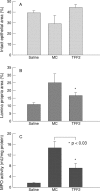Trefoil peptide TFF2 (spasmolytic polypeptide) potently accelerates healing and reduces inflammation in a rat model of colitis
- PMID: 10205199
- PMCID: PMC1727500
- DOI: 10.1136/gut.44.5.636
Trefoil peptide TFF2 (spasmolytic polypeptide) potently accelerates healing and reduces inflammation in a rat model of colitis
Abstract
Background: The trefoil peptides are major secretory products of mucus cells of the gastrointestinal tract and show increased expression after inflammatory or ulcerative damage. Recombinant human TFF2 (spasmolytic polypeptide) has been shown to be cytoprotective, and enhances repair in models of gastric injury.
Aims: To test the healing effects of recombinant human (h)TFF2 in a rat model of chronic colitis.
Methods: Colitis was induced by intracolonic administration of dinitrobenzene sulphonic acid in ethanol. Mucosal repair was quantified macroscopically, microscopically by image analysis of tissue histology, and by measuring myeloperoxidase activity.
Results: Initial validation studies showed that maximal injury and inflammation occurred at the end of the first week after colitis induction (active phase), and that spontaneous healing was complete by eight weeks. Once daily intrarectal application of hTFF2 (2.5 mg/kg; approximately 0.5 mg/rat) for five days after maximal damage had been sustained, reduced both microscopic and macroscopic injury by 80% and inflammatory index by 50% compared with vehicle controls. In addition, endogenous concentrations of rat TFF2 and TFF3 (intestinal trefoil factor) were increased in the active phase of colitis and were reduced to basal levels by hTFF2 treatment.
Conclusions: This study has shown that hTFF2 enhances the rate of colonic epithelial repair, and reduces local inflammation in a rat model of colitis, and suggests that luminal application of trefoil peptides may have therapeutic potential in the treatment of inflammatory bowel disease.
Figures









Similar articles
-
Luminal and parenteral TFF2 and TFF3 dimer and monomer in two models of experimental colitis in the rat.Regul Pept. 2005 Mar 30;126(3):163-71. doi: 10.1016/j.regpep.2004.09.007. Regul Pept. 2005. PMID: 15664663
-
Topical and intravenous administration of trefoil factors protect the gastric mucosa from ethanol-induced injury in the rat.Aliment Pharmacol Ther. 2000 Aug;14(8):1033-40. doi: 10.1046/j.1365-2036.2000.00796.x. Aliment Pharmacol Ther. 2000. PMID: 10930897
-
Metabolism of oral trefoil factor 2 (TFF2) and the effect of oral and parenteral TFF2 on gastric and duodenal ulcer healing in the rat.Gut. 1999 Oct;45(4):516-22. doi: 10.1136/gut.45.4.516. Gut. 1999. PMID: 10486358 Free PMC article.
-
Trefoil factors and human gastric cancer (review).Int J Mol Med. 2003 Jul;12(1):3-9. Int J Mol Med. 2003. PMID: 12792801 Review.
-
Trefoil peptides: what are they and what do they do?J R Coll Physicians Lond. 1997 Jan-Feb;31(1):37-41. J R Coll Physicians Lond. 1997. PMID: 9044196 Free PMC article. Review.
Cited by
-
Proteomics in gastroparesis: unique and overlapping protein signatures in diabetic and idiopathic gastroparesis.Am J Physiol Gastrointest Liver Physiol. 2019 Nov 1;317(5):G716-G726. doi: 10.1152/ajpgi.00115.2019. Epub 2019 Sep 4. Am J Physiol Gastrointest Liver Physiol. 2019. PMID: 31482734 Free PMC article.
-
Trefoil family factor 2 is expressed in murine gastric and immune cells and controls both gastrointestinal inflammation and systemic immune responses.Infect Immun. 2007 Jan;75(1):471-80. doi: 10.1128/IAI.02039-05. Epub 2006 Nov 13. Infect Immun. 2007. PMID: 17101660 Free PMC article.
-
TFF2 deficiency exacerbates weight loss and alters immune cell and cytokine profiles in DSS colitis, and this cannot be rescued by wild-type bone marrow.Am J Physiol Gastrointest Liver Physiol. 2015 Jan 1;308(1):G12-24. doi: 10.1152/ajpgi.00172.2014. Epub 2014 Oct 16. Am J Physiol Gastrointest Liver Physiol. 2015. PMID: 25324506 Free PMC article.
-
Chemical Synthesis of TFF3 Reveals Novel Mechanistic Insights and a Gut-Stable Metabolite.J Med Chem. 2021 Jul 8;64(13):9484-9495. doi: 10.1021/acs.jmedchem.1c00767. Epub 2021 Jun 18. J Med Chem. 2021. PMID: 34142550 Free PMC article.
-
High-Fat Diet-Induced Trefoil Factor Family Member 2 (TFF2) to Counteract the Immune-Mediated Damage in Mice.Animals (Basel). 2021 Jan 21;11(2):258. doi: 10.3390/ani11020258. Animals (Basel). 2021. PMID: 33494143 Free PMC article.
References
Publication types
MeSH terms
Substances
LinkOut - more resources
Full Text Sources
Other Literature Sources
Research Materials
